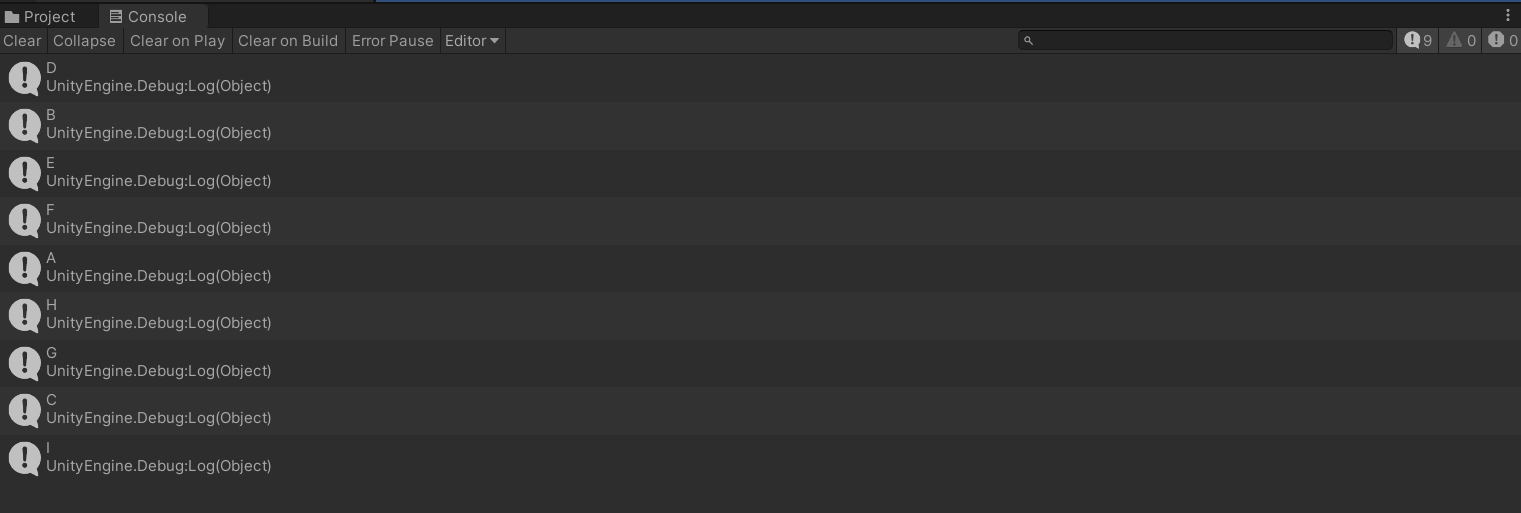二叉树遍历在Unity中的实现
前言:今天放一天,想到要放国庆假了就心烦气躁,躺床上又焦虑,回想起面试官的一副扑克脸,马上跳起来看了看数据结构。
今天复习了二叉树,包括一些基本概念和特性,当看到二叉树遍历的章节时,马上联想到了Unity的Hierachy面板中的游戏物体关系,就在Unity中仿造了一波”二叉树“;
准备工作:
先写一个二叉树类,成员包括自身名称value,左子树,右子树
public class BinaryTree { public string value; public BinaryTree Left; public BinaryTree Right; public BinaryTree(Transform root) { value = root.name; if (root.childCount==0) { return; } else if (root.childCount==1) { if (root.GetChild(0) != null) { Left = new BinaryTree(root.GetChild(0)); } else { Left = null; } } else if (root.childCount==2) { if (root.GetChild(0) != null) { Left = new BinaryTree(root.GetChild(0)); } else { Left = null; } if (root.GetChild(1) != null) { Right = new BinaryTree(root.GetChild(1)); } else { Right = null; } } } }
在Unity中添加若干子物体

因为Unity中,游戏物体的关系并非是《二叉树》,而是《树》,所以在代码中我特意添加判断子物体数,而且在Unity中不会出现左子树不存在,右子树存在的情况。
一、先序遍历
1.递归方式:
void NodeFirst(BinaryTree t) { if (t!=null) { Debug.Log(t.value); NodeFirst(t.Left); NodeFirst(t.Right); } }
2.非递归方式:
void TravalFirst(BinaryTree input) { BinaryTree T = input; Stack<BinaryTree> s = new Stack<BinaryTree>(); while (T!=null||s.Count>0) { while (T!=null) { Debug.Log(T.value); s.Push(T); T = T.Left; } T = s.Pop(); T = T.Right; } }
3.输出:

二、中序
1.递归
void NodeMid(BinaryTree t) { if (t != null) { NodeMid(t.Left); Debug.Log(t.value); NodeMid(t.Right); } }
2.非递归
void TravalMid(BinaryTree input) { BinaryTree T = input; Stack<BinaryTree> s = new Stack<BinaryTree>(); while (T!=null|| s.Count>0) { while (T!=null) { s.Push(T); T = T.Left; } T = s.Pop(); Debug.Log(T.value); T = T.Right; } }
3.输出

三、后序
1.递归
void NodeLast(BinaryTree t) { if (t != null) { NodeLast(t.Left); NodeLast(t.Right); Debug.Log(t.value); } }
2.非递归
void TravalLast(BinaryTree input) { BinaryTree T = input; Stack<BinaryTree> s = new Stack<BinaryTree>(); BinaryTree visited = null; while (T!=null||s.Count>0) { if (T!=null) { s.Push(T); T = T.Left; } else { T = s.Peek(); if (T.Right!=null&&visited!=T.Right) { T = T.Right; s.Push(T); T = T.Left; } else { T = s.Pop(); Debug.Log(T.value); visited = T; T = null; } } } }
这里单独解释一下,因为我做这个实在是想不出了,看了看网上的,其实我也是云里雾里的。这里不能像前两个一样,早早的把父节点弹出栈,需要先输出判断左右子树后,再弹出父节点。
3.输出

其实我更愿意用递归,因为非递归的可读性有点差。考虑到可执行性的原因,所以我又学习了一遍非递归的方式,主要还是使用栈的特性。加油,菜鸟也有鲲鹏之志




 浙公网安备 33010602011771号
浙公网安备 33010602011771号